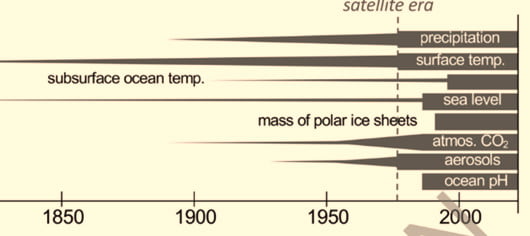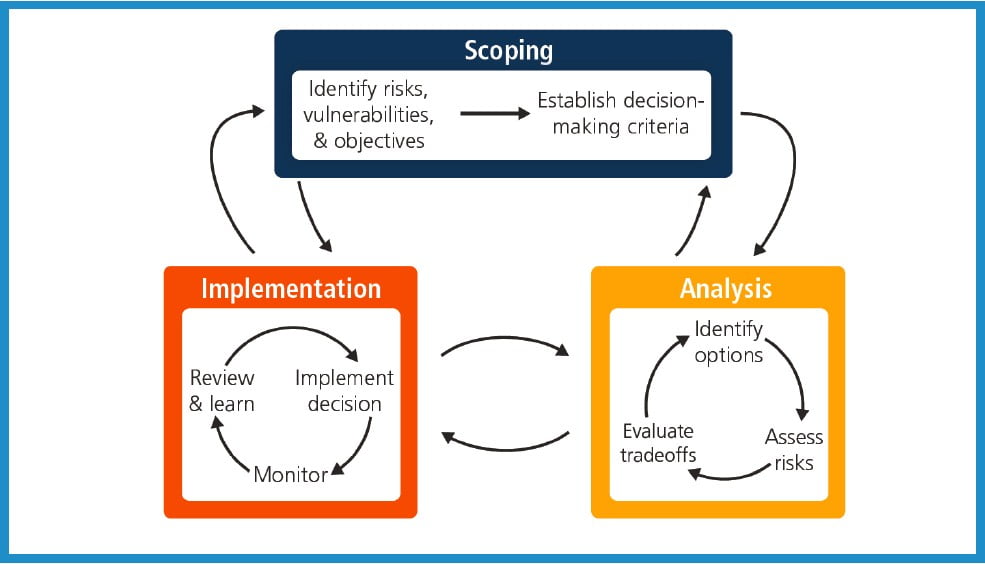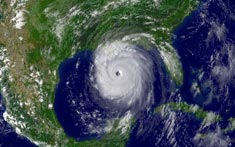
According to the IPCC report for Policymakers “Human influence is very likely the main driver of the global retreat of glaciers since the 1990s and the decrease in Arctic sea ice area between 1979–1988 and 2010–2019 (about 40% in September and about 10% in March). There has been no significant trend in Antarctic sea ice area from 1979 to 2020 due to regionally opposing trends and large internal variability. Human influence very likely contributed to the decrease in Northern Hemisphere spring snow cover since 1950. It is very likely that human influence has contributed to the observed surface melting of the Greenland Ice Sheet over the past two decades, but there is only limited evidence, with medium agreement, of human influence on the Antarctic Ice Sheet mass loss.”1

NASA https://www.nasa.gov/topics/earth/features/ice-min-approach.html
The Arctic is largely sea ice with some parts of countries intruding
Sea ice typically covers about 14 to 16 million km2 in late winter in the Arctic

https://www.nasa.gov/audience/forstudents/k-4/stories/nasa-knows/what-is-antarctica-k4.html
Antarctica is a CONTINENT with land mass under the ice, mountains, and volcanoes.
Antarctica is 14 million km2 PLUS 17 to 20 million km2 of sea ice in the Antarctic Southern Ocean in winter.

- Using your knowledge of global warming explain why the four changes described above have occurred.

*Losing mass – this means that more ice melts than is gained via snowfall in a given year.
- Change two above suggests that there will be more precipitation (snowfall and rainfall) in Arctic and Antarctic regions. Complete the futures exercise below to consider what this change could mean for those regions.
- What possible futures are there for the Arctic and Antarctic with increased precipitation?
- What probable futures are there for the Arctic and Antarctic with increased precipitation?
- What preferable futures exist for these regions? Here you might want to consider the key role these regions play in regulating our global climate.
Changes to the Greenland and Antarctic ice sheet.
The graphic below shows Greenland Ice Sheet cumulative mass changes in gigatonnes (recently observed and projected by models under SSP1-2.6 and SSP5-8.5 scenarios) and equivalent sea level change (in metres). Maps show recent elevation changes (metres/year).
- SSP1-2.6: Global CO2 emissions are cut severely, but not as fast, reaching net-zero after 2050. Temperatures stabilize around 1.8°C higher by the end of the century.
- SSP5-8.5: Current CO2 emissions levels roughly double by 2050. The global economy grows quickly, but this growth is fuelled by exploiting fossil fuels and energy-intensive lifestyles. By 2100, the average global temperature is a scorching 4.4°C higher.

- Using the graphs on ice mass change complete the table below.
SIMPLE TABLE

A gigaton is a billion tonnes. It is roughly equivalent to the mass all of the living mammals other than humans on earth.
- Which of the two areas, Greenland or Antarctica, will be most affected by climate change in 2100? Use data from the two graphs and maps to justify your view.
Projected climate changes in the Polar regions
Look carefully at the graphic below, it shows projected changes in the future (SSP5-8.5 scenario) in mean annual temperature and total precipitation at 2°C global warming compared to 1850–1900 for the Arctic (left) and Antarctic (right).
Answer the questions below:

Temperature
- What is the projected change for Greenland (G)?
- What is the projected change for Lapland (L)?
- What is the projected change for Siberia (S)?
- Which parts of the Arctic will suffer the most from temperature changes under the IPCC’s most extreme climate change scenario?
- What is the projected temperature change for the Antarctic Peninsula (P)?
- What is the projected temperature change at Vostok (V)?
Precipitation
- What is the projected change for Greenland?
- What is the projected change for Lapland?
- What is the projected change for Siberia?
- Which parts of the Arctic will suffer the most from precipitation changes under the IPCC’s most extreme climate change scenario?
- What is the projected precipitation change for the Antarctic peninsula?
- What is the projected precipitation change at Vostok?
- Which areas are likely to suffer the most change, the oceans or the land masses?
- Conduct research online, why is it significant for ice melting that the oceans warm? (e.g. https://www.worldwildlife.org/pages/why-are-glaciers-and-sea-ice-melting)
Extension
Geographic Information Systems (GIS) – run the simulation at this website https://sealevel.nasa.gov/vesl/web/sea-level/slr-antarctica/.
Describe the changes that take place to try to explain them.

Sources
- IPCC, 2021: Climate Change 2021: The Physical Science Basis. Contribution of Working Group I to the Sixth Assessment Report of the Intergovernmental Panel on Climate Change [Masson-Delmotte, V., P. Zhai, A. Pirani, S.L. Connors, C. Péan, S. Berger, N. Caud, Y. Chen, L. Goldfarb, M.I. Gomis, M. Huang, K. Leitzell, E. Lonnoy, J.B.R. Matthews, T.K. Maycock, T. Waterfield, O. Yelekçi, R. Yu, and B. Zhou (eds.)]. Cambridge University Press. In Press. P.10. Accessed 28th November 2021 at Sixth Assessment Report (ipcc.ch)
- ch. 2021. Regional fact sheet – Polar Regions. [online] Available at: https://www.ipcc.ch/report/ar6/wg1/downloads/factsheets/IPCC_AR6_WGI_Regional_Fact_Sheet_Polar_regions.pdf [Accessed 28 November 2021].



